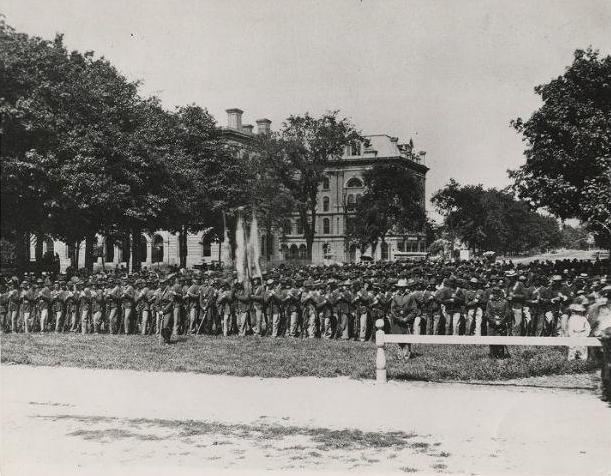 | ||
Cleveland, Ohio, was an important Northern city during the American Civil War. It provided thousands of troops to the Union Army, as well as millions of dollars in supplies, equipment, food, and support to the soldiers.
Contents
Public sentiments on the war
Prior to the Civil War, residents of Cleveland viewed the slaveholding South based on political affiliation. While a majority of Clevelanders tended to side with the abolitionist North, not all of them loathed slavery, nor were all convinced that a civil war would resolve ideological differences between North and South. As the 1860 election year approached and impending clouds of war loomed, Cleveland's newspapers reflected divisions in the city. For example, The Cleveland Herald and Gazette and The Cleveland Leader, both largely Republican papers, argued that Southern injustices had driven John Brown to raid Harpers Ferry in October 1859. The Plain Dealer, a largely Democratic publication, blamed Brown and abolitionist Republicans for the raid.
Republican leader Abraham Lincoln spoke in the city during the 1859 gubernatorial election, and won 58% of the vote in 9 of 11 wards for the Presidency in 1860. As the secession crisis loomed closer, the partisan rhetoric of Cleveland newspapers became more and more heated. The Herald celebrated Lincoln's victory as one of right over wrong, of Unionists over secession-minded southern Democrats, while the Leader dismissed threats of the South's secession. The Plain Dealer, meanwhile, warned that secession was imminent. Lincoln came through Cleveland on his way to Washington, D.C. for his inauguration. When war finally did break out with the Confederate firing on Fort Sumter in April 1861, Cleveland's Democrats and Republicans decided to end their dispute and united to form the National Union party to support Lincoln's war effort. However, this coalition did not go untested.
Economic impact of the war
The Civil War years brought an economic boom to Cleveland. The city made the transition from a small town to an industrial giant. Railroad iron and gun-carriage axles were manufactured for military use. Due to the cutoff of Southern trade, Cleveland opened its first tobacco factory, T. Maxfield & Co., in 1862. The city's garment industry also began to prosper. The German Woolen Factory (also in 1862) became the first company to manufacture wool cloth in Cleveland. By 1865, its banks held $2.25 million in capital and $3.7 million in deposits. In 1863, 22% of all U.S. warships built for use on the Great Lakes were built in Cleveland. That figure increased by 1865 to 44%.
Civilian aid to the military centered on establishment and maintenance of the Soldiers' Aid Society of Northern Ohio (1861), the U.S. General Hospital (1862), Camp Taylor (1861), and Camp Cleveland (1862). Food, blankets, and reading material were provided by citizens to recruits at both military camps until government stores and equipment could be distributed.
Memorialization and lingering issues
When the war ended, Cleveland welcomed home troops after service in the field, treating them to a meal and a short welcoming ceremony on Public Square before they marched to Camp Cleveland for payment and discharge from the army. Those Clevelanders who died in the war were honored at Woodland Cemetery with the memorials commemorating the 7th Ohio Volunteer Infantry Regiment and the 23rd Ohio Volunteer Infantry Regiment. Another famous regiment with Cleveland ties was the 8th Ohio Infantry, which helped repel Pickett's Charge. In April 1865, the Lincoln funeral train stopped briefly in Cleveland, and his coffin was displayed on Public Square.
The issue of full emancipation still lingered. The Herald and the Leader had supported the proposed Emancipation Proclamation of January 1, 1863, commending Lincoln "for the stalwart blow he struck for freedom and for the peace and future tranquility of the Union." The Plain Dealer, on the other hand, argued that the only purpose of the war was to preserve the Union and that making "citizens of the entire black population" would ultimately tarnish the white race.
Following the war, the Soldier's and Sailors' Monument was erected in Public Square.
